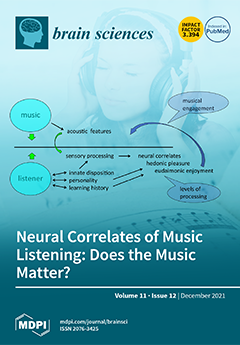The aim of the study was to find the association between SIRT1 concentration,
SIRT1 rs3758391, rs3818292, rs7895833 polymorphisms and clinical manifestations of pituitary adenoma (PA). The study included 108 patients with PA and 216 healthy individuals. Using commercial kits, DNA was extracted from
[...] Read more.
The aim of the study was to find the association between SIRT1 concentration,
SIRT1 rs3758391, rs3818292, rs7895833 polymorphisms and clinical manifestations of pituitary adenoma (PA). The study included 108 patients with PA and 216 healthy individuals. Using commercial kits, DNA was extracted from peripheral blood leukocytes. To determine the PA and control group subjects genotypes was used real-time PCR method, for SIRT concentration measurement we used ELISA method. The statistical data analysis was completed using the “BM SPSS Statistics 20.0” software. Results: We performed statistical analysis of SNPs in the patient and healthy controls and patients’ subgroups and found statistically significant differences in rs7895833 genotype (A/A, A/G, G/G) distributions between the active PA and control groups (67.9%, 24.6%, 5.7% vs. 72.2%, 27.3%, 0.5%;
p = 0.02) Also, the results showed that the rs7895833 G/G genotype is associated with about 13-fold increased odds of active PA development compared to the A/A (OR = 13.95% CI: 1.314–128.632;
p = 0.028) and both A/A and A/G genotypes (OR = 12.9; 95% CI: 1.314–126.624;
p = 0.028). There is ample evidence that SIRT1 in the pituitary and other target organs modifies the synthesis, secretion, and activity of hormones to trigger adaptive responses, thus we decided to include this in our study. When determining the serum concentration of SIRT1, we did not find a statistically significant difference between the PA group and the control group. SIRT1 serum level was statistically significantly higher in women with PA than in healthy control women (1.115 (3.748) vs. 136 (0.211);
p = 0.008). To conclude—
SIRT1 rs7895833 G/G genotype is associated with about 13-fold increased odds of active PA development compared to the A/A and both A/A and A/G genotypes. SIRT1 serum levels are higher in women with PA than in healthy women.
Full article






